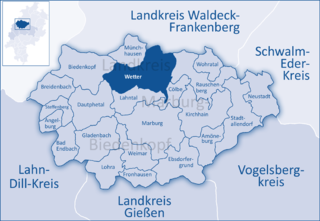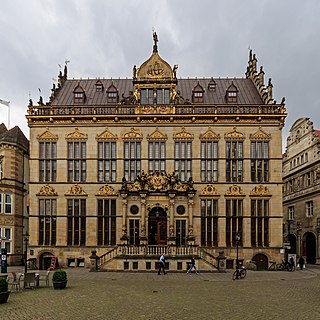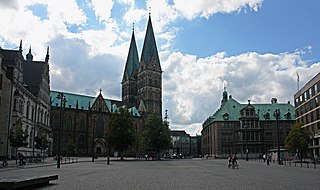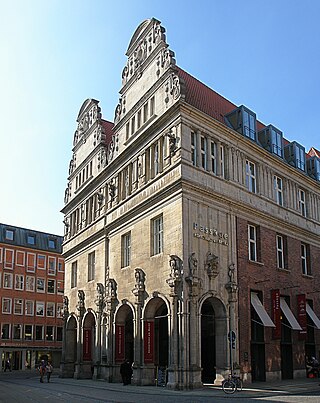
Wetter (Hessen) is a small town in Hesse, Germany. The rather unusual designation Wetter (Hessen-Nassau) stems from a time when the town belonged to the Prussian province of the same name, and nowadays is only used by the railway – even today, the railway station in town bears this name.

Apothecary is an archaic English term for a medical professional who formulates and dispenses materia medica (medicine) to physicians, surgeons and patients. The modern terms 'pharmacist' and 'chemist' have taken over this role.

Heinrich Emanuel Merck was an apothecary whose descendants are the founders of Merck and Company and Merck KGaA.

The Pharmacy Museum of the University of Basel shows in its permanent collection the history of medicinal remedies and their preparation. Designed as a collection of specimens for study purposes, the museum was founded in 1924 by Josef Anton Häfliger (1873–1954) and has been preserved to this day in its original form as a 'scientific cabinet'.

The Raeapteek is a pharmacy in the center of Tallinn, Estonia.

The Adler-Apotheke was a former brass producing factory in the German city of Stolberg. The building was founded in 1575 by Leonard Schleicher. In the 18th century it became the first pharmacy in the district of Aachen. Currently the building is protected as a cultural heritage.

Haus der Stadtsparkasse is a Rococo landmark on the "Marktplatz" in Bremen, Germany. It was completed in the 1950s combining the historic front gable from another site with the more recent architecture of the remainder of the building.

The old Rathscafé, now named Deutsches Haus, is a listed building on the market place (Marktplatz) in Bremen. It is part of the monument ensemble No. 1–21.

The Bremer Marktplatz is a square situated in the centre of the Hanseatic City of Bremen. One of the oldest public squares in the city, it covers an area of 3,484 m2 (37,500 sq ft). It is no longer used as a market place except for the Christmas market and the annual Freimarkt Fair at the end of October.

The Schütting, situated on the Marktplatz in Bremen, initially served the city's merchants and tradesmen as a guild house. In 1849, it became Bremen's chamber of commerce. Since 1973, it has been under monument protection. It lies on the south site of the Bremen marketplaces directly across from the town hall.

The New Town Hall has stood on the Domshof in the centre of Bremen, Germany since 1913. Located behind the Unser-Lieben-Frauen-Kirchhof cemetery, it is adjacent to the older section of the Town Hall with which it forms a harmonious ensemble. Among its sumptuous rooms decorated with local artefacts, the New Town Hall houses the Senate Chamber used by the Senate for its regular meetings and the Great Hall, a venue for official receptions. In 2004, Bremen Town Hall was listed as a UNESCO World Heritage Site, together with the Roland of Bremen, because of its outstanding architecture and testimony to the development of civic autonomy during the Holy Roman Empire.

The Domshof is a town square in Bremen, north of the cathedral and the Marktplatz. The Domshof is used for markets as well as larger outdoor events, particularly May Day demonstrations.

Domsheide is a major square in the city of Bremen, Germany. It is located east of the Marktplatz and south of Bremen Cathedral. Streets leading to it include Ostertorstraße, Dechanatstraße, Balgebrückstraße and Violenstraße. It contains a number of important buildings, including the main post office, the courthouse, the cathedral precinct with the bell, and the annex to the stock market building. It is one of three main hubs of the public transport network, with most tram routes and two important bus lines crossing the square. The design of the Domsheide is relatively uneven, characterized by materials such as sandstone, dark red brick, red and yellow clinkers, render, concrete and marble.

The Kontorhaus am Markt in Bremen is a historical building in the city centre of Bremen. Today, it is used as a shopping mall. It is situated at the Bremer Marktplatz between three streets: Langenstrasse 2/8, Stintbruecke 1 and Bredenstrasse 13.

The Langenstraße is a historical street in the old town of Bremen in the north of Germany. First mentioned in 1234, it is one of Bremen's oldest streets and one of the most important for the city's merchants. It no doubt originated at the time when the first settlements grew up on the north bank of the Balge. It runs west from the Marktplatz parallel to the River Weser over Bürgermeister-Smidt-Straße to Geeren. Many of the street's historic buildings were seriously damaged during aerial bombings in the Second World War but were carefully reconstructed in the postwar period.

The Glockenspiel House is a building in Bremen in the north of Germany. With its 30 bells of Meissen porcelain, the carillon (Glockenspiel) chimes three times a day while wooden panels depicting pioneering seafarers and aviators appear on a rotating mechanism inside the tower.

The Focke Museum is the museum of history and the history of art for the city and state of Bremen. It was formed in 1924 by the merger of a museum of industry and commerce and the previous historical museum, and is named for the founder of the latter, Johann Focke (1848–1922), a Bremen privy councillor and father of Henrich Focke. It is located in 4.5 hectares of grounds in the Riensberg neighbourhood of the city. In addition to a main building which opened in 1964 and was extended in 2002, the museum complex includes buildings dating from the 16th to the 19th centuries.
Friedrich Jacob Merck was a German pharmacist and a member of the Merck family. He was the founder of the world's oldest pharmaceutical company, now known as the Merck Group, which was established in 1668.

The Lower Market Square is the central square in the historic town of Görlitz. The city's town hall and thus most of the administration have been located on this square since 1350. Many of the city's Renaissance-styled buildings were built here.

The Altes Rathaus at Bonner Marktplatz was built between 1737 and 1738 in the Rococo style by the electoral court architect Michael Leveilly; however, it was not completely finished until around 1780. The four-storey building has seven window axes and a gambrel with dormers. It stands as a Baudenkmal under Cultural heritage management.





















